Chromatic Conductive Polymer Nanocomposites of Poly (p-Phenylene Ethynylene)s and Single-Walled Carbon Nanotubes
Abstract
1. Introduction
2. Materials and Methods
3. Results
3.1. Chromatic Dispersion of SWNT-PPE Nanocomposites
3.2. Chromatic Nanocomposites of PPE/SWNT
4. Conclusions
Author Contributions
Funding
Acknowledgments
Conflicts of Interest
References
- Negri, V.; Pacheco-Torres, J.; Calle, D.; López-Larrubia, P. Carbon nanotubes in biomedicine. Top. Curr. Chem. 2020, 378, 15. [Google Scholar] [CrossRef] [PubMed]
- Vetrivel, R.; Navinselvak, C.; Samuel Ratna Kumar, P.S. Carbon nanotubes and its applications—A review. Int. J. Mech. Prod. Eng. Res. Dev. 2011, 2, 1099–1107. [Google Scholar]
- Pan, H.; Li, J.; Feng, Y.P. Carbon nanotubes for supercapacitor. Nanoscale Res. Lett. 2010, 5, 654–668. [Google Scholar] [CrossRef]
- Camilli, L.; Passacantando, M. Advances on sensors based on carbon nanotubes. Chemosensors 2018, 6, 62. [Google Scholar] [CrossRef]
- Zhang, S.; Kumar, S. Carbon nanotubes as liquid crystals. Small 2008, 4, 1270–1283. [Google Scholar] [CrossRef]
- Zhang, S.; Kinloch, I.A.; Windle, A.H. Mesogenicity drives fractionation in lyotropic aqueous suspensions of multiwall car-bon nanotubes. Nano Lett. 2006, 6, 568–572. [Google Scholar] [CrossRef]
- Dyke, C.A.; Tour, J. Covalent functionalization of single-walled carbon nanotubes for materials applications. J. Phys. Chem. A 2004, 108, 11151–11159. [Google Scholar] [CrossRef]
- Figueiredo, D.T.; Correia, A.A.S.; Hunkeler, D.; Rasteiro, M.G.B. Surfactants for dispersion of carbon nanotubes applied in soil stabilization. Colloids Surf. A Physicochem. Eng. Asp. 2015, 480, 405–412. [Google Scholar] [CrossRef]
- Samanta, S.K.; Fritsch, M.; Scherf, U.; Gomulya, W.; Bisri, S.Z.; Loi, M.A. Conjugated polymer-assisted dispersion of single-wall carbon nanotubes: The power of polymer wrapping. Accounts Chem. Res. 2014, 47, 2446–2456. [Google Scholar] [CrossRef] [PubMed]
- Qiu, Z.; Hammer, B.A.; Müllen, K. Conjugated polymers-problems and promises. Prog. Polym. Sci. 2020, 100, 101179. [Google Scholar] [CrossRef]
- Zhang, Z.; Liao, M.; Lou, H.; Hu, Y.; Sun, X.; Peng, H. Conjugated polymers for flexible energy harvesting and storage. Adv. Mater. 2018, 30, e1704261. [Google Scholar] [CrossRef]
- Inal, S.; Rivnay, J.; Suiu, A.-O.; Malliaras, G.G.; McCulloch, I. Conjugated polymers in bioelectronics. Accounts Chem. Res. 2018, 51, 1368–1376. [Google Scholar] [CrossRef] [PubMed]
- Lee, H.W.; You, W.; Barman, S.; Hellstrom, S.; Lemieux, M.C.; Oh, J.H.; Liu, S.; Fujiwara, T.; Wang, W.M.; Chen, B.; et al. Lyotropic liquid-crystalline solutions of high-concentration dispersions of single-walled carbon nanotubes with conjugated polymers. Small 2009, 5, 1019–1024. [Google Scholar] [CrossRef]
- Chen, Y.; Xu, Y.; Wang, Q.; Gunasinghe, R.N.; Wang, X.-Q.; Pang, Y. Highly selective dispersion of carbon nanotubes by using poly(phenyleneethynylene)-guided supermolecular assembly. Small 2013, 9, 870–875. [Google Scholar] [CrossRef] [PubMed]
- Narizzano, R.; Nicolini, C. Mechanism of conjugated polymer organization on SWNT surfaces. Macromol. Rapid Commun. 2005, 26, 381–385. [Google Scholar] [CrossRef]
- Matos, M.; Pinho, S.; Tagarielli, V. Predictions of the electrical conductivity of composites of polymers and carbon nanotubes by an artificial neural network. Scr. Mater. 2019, 166, 117–121. [Google Scholar] [CrossRef]
- Blighe, F.M.; Hernandez, Y.R.; Blau, W.J.; Coleman, J.N. Observation of percolation-like scaling-far from the percolation threshold-in high volume fraction, high conductivity polymer-nanotube composite films. Adv. Mater. 2007, 19, 4443–4447. [Google Scholar] [CrossRef]
- Rosario-Canales, M.R.; Deria, P.; Kang, Y.; Therien, M.; Santiago-Aviles, J. Evaluation of composite electronic materials based upon single-wall carbon nanotubes and highly charged poly(aryleneethynylene)s for supercapacitor applications. ECS Trans. 2009, 16, 93–101. [Google Scholar] [CrossRef]
- Alturaif, H.A.; Alothman, Z.A.; Shapter, J.G.; Wabaidur, S.M. Use of carbon nanotubes (CNTs) with polymers in solar cells. Molecules 2014, 19, 17329–17344. [Google Scholar] [CrossRef]
- Landi, B.J.; Raffaelle, R.P.; Castro, S.L.; Bailey, S.G. Single-wall carbon nanotube-polymer solar cells. Prog. Photovolt. Res. Appl. 2005, 13, 165–172. [Google Scholar] [CrossRef]
- Lee, S.-H.; Ko, S.-J.; Eom, S.H.; Kim, H.; Kim, D.W.; Lee, C.; Yoon, S.C. Composite interlayer consisting of alcohol-soluble polyfluorene and carbon nanotubes for efficient polymer solar cells. ACS Appl. Mater. Interfaces 2020, 12, 14244–14253. [Google Scholar] [CrossRef] [PubMed]
- Schießl, S.P.; Fröhlich, N.; Held, M.; Gannott, F.; Schweiger, M.; Forster, M.; Scherf, U.; Zaumseil, J. Polymer-sorted semiconducting carbon nanotube networks for high-performance ambipolar field-effect transistors. ACS Appl. Mater. Interfaces 2014, 7, 682–689. [Google Scholar] [CrossRef]
- Chua, C.; Yeoh, K.H.; Woon, K. Hybrid carbon nanotube/polymer heterointerface organic field effect transistor. Thin Solid Films 2014, 556, 495–498. [Google Scholar] [CrossRef]
- Park, S.J.; Lee, J.; Seo, S.E.; Kim, K.H.; Park, C.S.; Lee, S.H.; Ban, H.S.; Lee, B.D.; Song, H.S.; Kim, J.; et al. High-performance conducting polymer nanotube-based liquid-ion gated field-effect transistor aptasensor for dopamine exocytosis. Sci. Rep. 2020, 10, 1–12. [Google Scholar] [CrossRef] [PubMed]
- Bunz, U.H.F. Poly(aryleneethynylene)s. Macromol. Rapid Commun. 2009, 30, 772–805. [Google Scholar] [CrossRef]
- Bunz, U.H.F.; Seehafer, K.; Bender, M.; Porz, M. Poly(aryleneethynylene)s (PAE) as paradigmatic sensor cores. Chem. Soc. Rev. 2014, 44, 4322–4336. [Google Scholar] [CrossRef]
- Ortiz, M.; Yu, C.; Jin, Y.; Zhang, W. Poly(aryleneethynylene)s: Properties, applications and synthesis through alkyne metathesis. Top. Curr. Chem. 2017, 375, 69. [Google Scholar] [CrossRef]
- Lebouch, N.; Garreau, S.; Louarn, G.; Belletête, M.; Durocher, G.; Leclerc, M. Structural study of the thermochromic transition in poly(2,5-dialkyl-p-phenyleneethynylene)s. Macromolecules 2005, 38, 9631–9637. [Google Scholar] [CrossRef]
- Bunz, U.H.F. Poly(aryleneethynylene)s: Syntheses, properties, structures, and applications. Chem. Rev. 2000, 100, 1605–1644. [Google Scholar] [CrossRef]
- Kang, W.Y.; Park, J.S. Supramolecular composite of single-walled carbon nanotubes with oligo(p-phenyleneethynylene)s-graft-poly(ethyleneoxide)s. Fibers Polym. 2012, 13, 1219–1224. [Google Scholar] [CrossRef]
- Ramos, J.C.; Flores, J.R.; Turlakov, G.; Moggio, I.; Arias, E.; Rodríguez, G. Self-assembly of a poly(phenyleneethynylene) on multiwall carbon nanotubes: Correlation of structural and optoelectronic properties towards solar cells application. J. Mol. Struct. 2020, 1222, 128845. [Google Scholar] [CrossRef]
- Kang, Y.K.; Lee, O.-S.; Deria, P.; Kim, S.H.; Park, T.-H.; Bonnell, D.A.; Saven, J.G.; Therien, M.J. Helical wrapping of single-walled carbon nanotubes by water soluble poly(p-phenyleneethynylene). Nano Lett. 2009, 9, 1414–1418. [Google Scholar] [CrossRef]
- Chen, J.; Liu, H.; Weimer, W.A.; Halls, M.D.; Waldeck, D.H.; Walker, G.C. Noncovalent engineering of carbon nanotube surfaces by rigid, functional conjugated polymers. J. Am. Chem. Soc. 2002, 124, 9034–9035. [Google Scholar] [CrossRef] [PubMed]
- Jakubka, F.; Schießl, S.P.; Martin, S.; Englert, J.M.; Hauke, F.; Hirsch, A.; Zaumseil, J. Effect of polymer molecular weight and solution parameters on selective dispersion of single-walled carbon nanotubes. ACS Macro Lett. 2012, 1, 815–819. [Google Scholar] [CrossRef]
- Chen, J.; Xue, C.; Ramasubramaniam, R.; Liu, H. A new method for the preparation of stable carbon nanotube organogels. Carbon 2006, 44, 2142–2146. [Google Scholar] [CrossRef]
- Abdou, J.P.; Braggin, G.A.; Luo, Y.; Stevenson, A.R.; Chun, D.; Zhang, S. Graphene-induced oriented interfacial microstructures in single fiber polymer composites. ACS Appl. Mater. Interfaces 2015, 7, 13620–13626. [Google Scholar] [CrossRef]
- Abdou, J.P.; Reynolds, K.J.; Pfau, M.R.; van Staden, J.; Braggin, G.A.; Tajaddod, N.; Minus, M.; Reguero, V.; Vilatela, J.J.; Zhang, S. Interfacial crystallization of isotactic polypropylene surrounding macroscopic carbon nanotube and graphene fibers. Polymer 2016, 91, 136–145. [Google Scholar] [CrossRef]
- Zhang, S.; Zhu, L.; Wong, C.-P.; Kumar, S. Polymer-infiltrated aligned carbon nanotube fibers by in situ polymerization. Macromol. Rapid Commun. 2009, 30, 1936–1939. [Google Scholar] [CrossRef] [PubMed]
- Armas, J.A.; Reynolds, K.J.; Marsh, Z.M.; Fernández-Blázquez, J.P.; Ayala, D.; Cronin, A.D.; Del Aguila, J.; Fideldy, R.; Abdou, J.P.; Bilger, D.W.; et al. Supramolecular assembly of oriented spherulitic crystals of conjugated polymers surrounding carbon nanotube fibers. Macromol. Rapid Commun. 2019, 40, e1900098. [Google Scholar] [CrossRef] [PubMed]
- Luo, Y.; Santos, F.A.; Wagner, T.W.; Tsoi, E.; Zhang, S. Dynamic interactions between poly(3-hexylthiophene) and single-walled carbon nanotubes in marginal solvent. J. Phys. Chem. B 2014, 118, 6038–6046. [Google Scholar] [CrossRef] [PubMed]
- Campbell, K.; Zappas, A.; Bunz, U.; Thio, Y.S.; Bucknall, D.G. Chemistry fluorescence quenching of a poly ( para-phenylene ethynylenes ) by C 60 fullerenes. J. Photochem. Photobiol. A Chem. 2012, 249, 41–46. [Google Scholar] [CrossRef]
- Adachi, N.; Okada, M.; Sugeno, M.; Norioka, T. Fluorescence turn-on chemical sensor based on water-soluble conjugated polymer/single-walled carbon nanotube composite. J. Appl. Polym. Sci. 2016, 133, 43301. [Google Scholar] [CrossRef]
- Mao, J.; Liu, Q.; Lv, X.; Liu, Z.; Huang, Y.; Ma, Y.; Chen, Y.; Yin, S. A water-soluble hybrid material of single-walled carbon nanotubes with an amphiphilic poly(phenyleneethynylene): Preparation, characterization, and photovoltaic properties. J. Nanosci. Nanotechnol. 2007, 7, 2709–2718. [Google Scholar] [CrossRef] [PubMed]
- Zhang, S.; Lin, W.; Wong, C.-P.; Bucknall, D.G.; Kumar, S. Nanocomposites of carbon nanotube fibers prepared by polymer crystallization. ACS Appl. Mater. Interfaces 2010, 2, 1642–1647. [Google Scholar] [CrossRef] [PubMed]
- Sreekumar, T.V.; Liu, T.; Kumar, S.; Ericson, L.M.; Hauge, R.H.; Smalley, R.E. Single-wall carbon nanotube films. Chem. Mater. 2003, 15, 175–178. [Google Scholar] [CrossRef]
- Guo, H.; Sreekumar, T.; Liu, T.; Minus, M.; Kumar, S. Structure and properties of polyacrylonitrile/single wall carbon nanotube composite films. Polymer 2005, 46, 3001–3005. [Google Scholar] [CrossRef]
- Kilbride, B.E.; Coleman, J.N.; Fraysse, J.; Fournet, P.; Cadek, M.; Drury, A.; Hutzler, S.; Roth, S.; Blau, W. Experimental observation of scaling laws for alternating current and direct current conductivity in polymer-carbon nanotube composite thin films. J. Appl. Phys. 2002, 92, 4024–4030. [Google Scholar] [CrossRef]
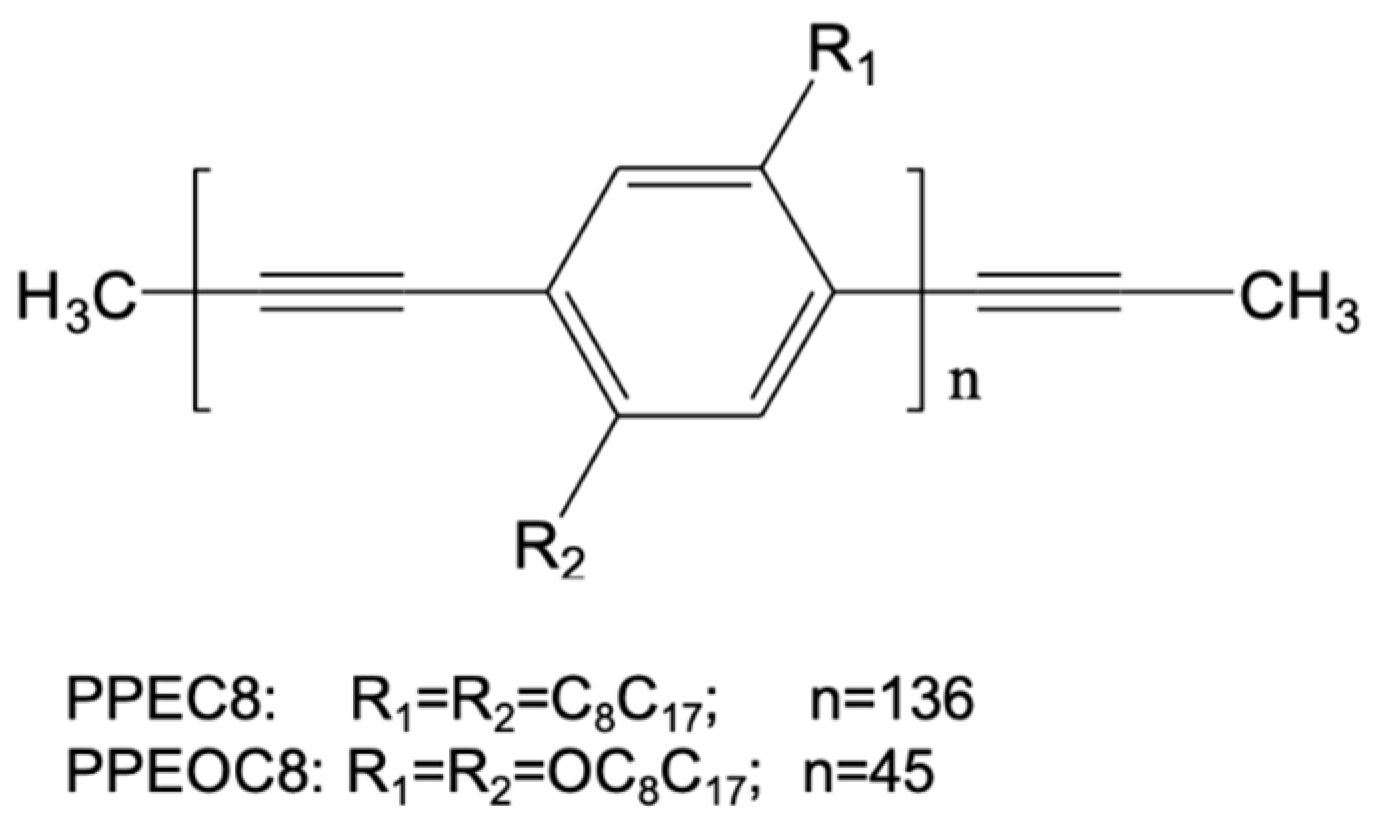
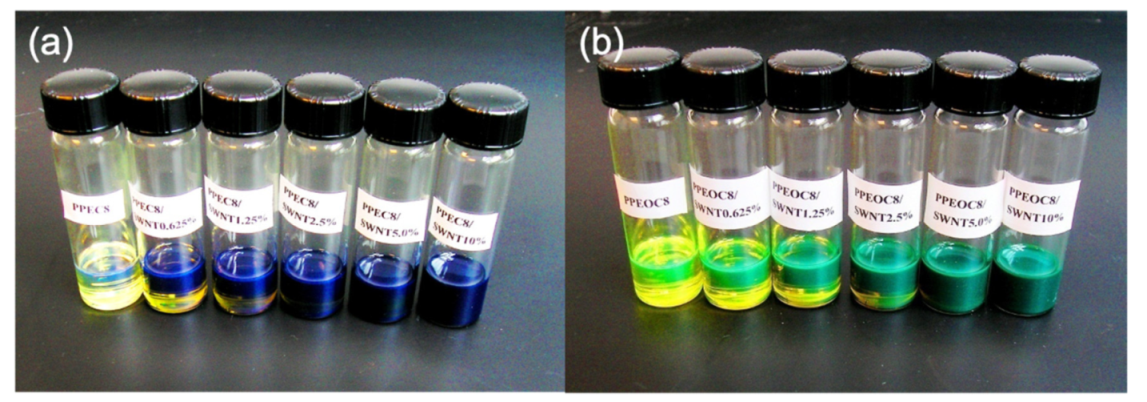


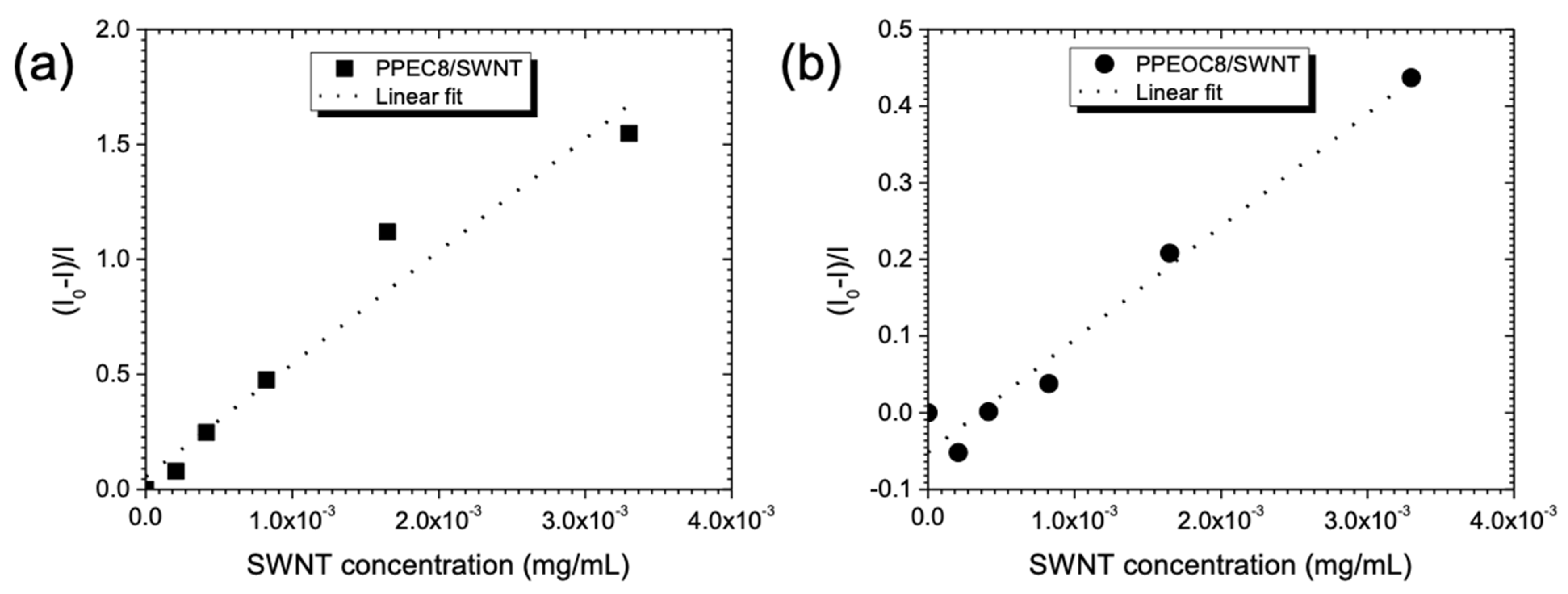
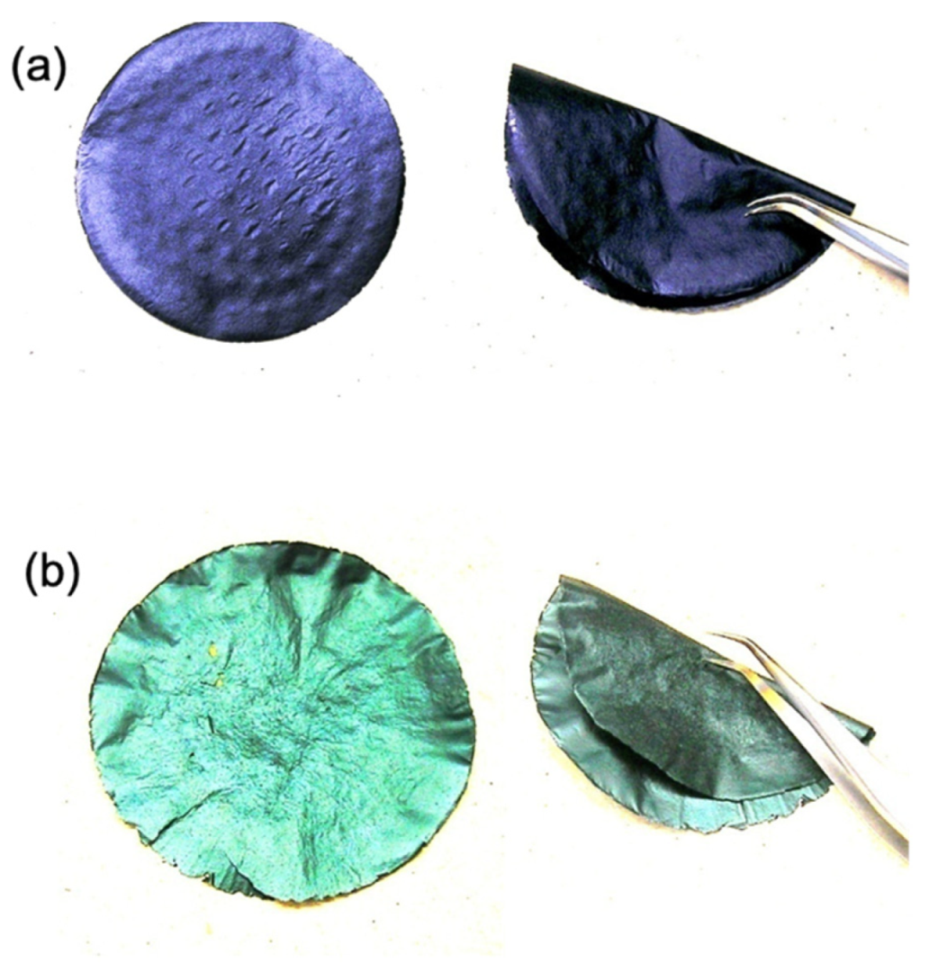


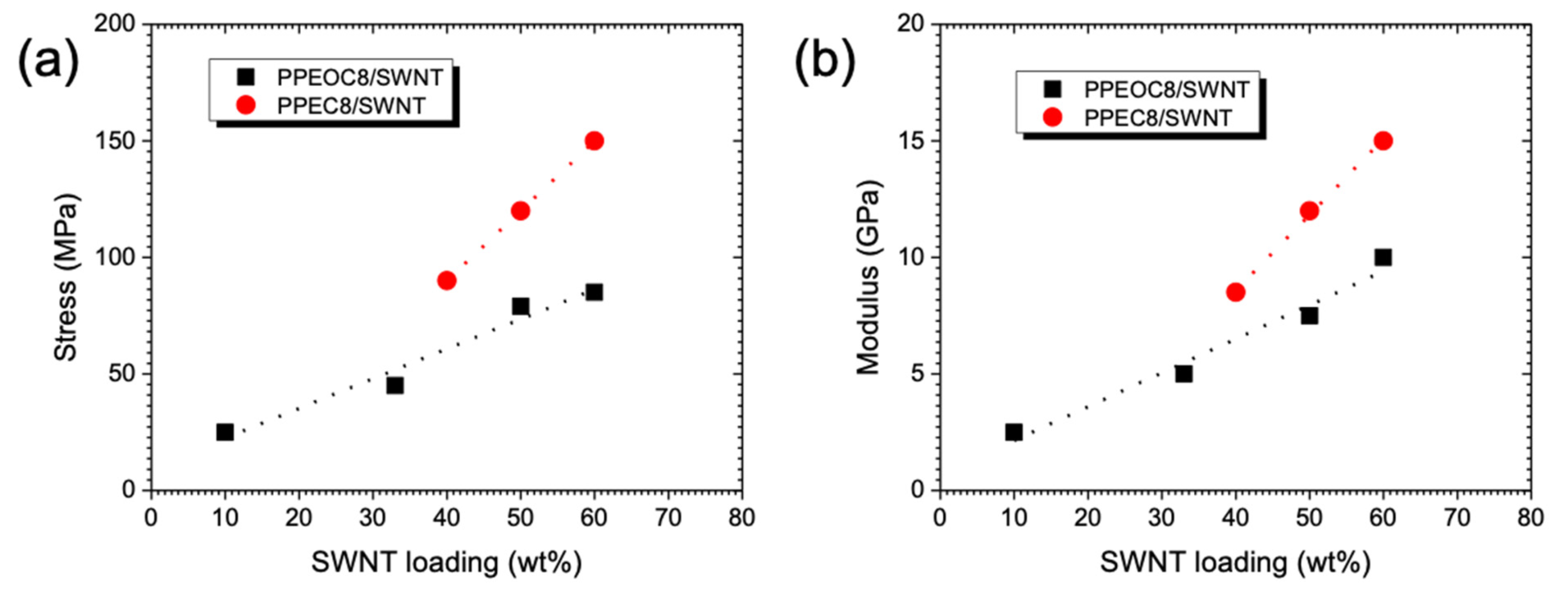

| Polymer | DCB | Chloroform | Toluene |
|---|---|---|---|
| PPEC8 | 2.5 | 2.2 | 0.5 |
| PPEOC8 | 1.5 | 1.5 | 0.3 |
Publisher’s Note: MDPI stays neutral with regard to jurisdictional claims in published maps and institutional affiliations. |
© 2021 by the authors. Licensee MDPI, Basel, Switzerland. This article is an open access article distributed under the terms and conditions of the Creative Commons Attribution (CC BY) license (https://creativecommons.org/licenses/by/4.0/).
Share and Cite
Zhang, S.; Bunz, U.H.F.; Bucknall, D.G. Chromatic Conductive Polymer Nanocomposites of Poly (p-Phenylene Ethynylene)s and Single-Walled Carbon Nanotubes. J. Compos. Sci. 2021, 5, 158. https://doi.org/10.3390/jcs5060158
Zhang S, Bunz UHF, Bucknall DG. Chromatic Conductive Polymer Nanocomposites of Poly (p-Phenylene Ethynylene)s and Single-Walled Carbon Nanotubes. Journal of Composites Science. 2021; 5(6):158. https://doi.org/10.3390/jcs5060158
Chicago/Turabian StyleZhang, Shanju, Uwe H. F. Bunz, and David G. Bucknall. 2021. "Chromatic Conductive Polymer Nanocomposites of Poly (p-Phenylene Ethynylene)s and Single-Walled Carbon Nanotubes" Journal of Composites Science 5, no. 6: 158. https://doi.org/10.3390/jcs5060158
APA StyleZhang, S., Bunz, U. H. F., & Bucknall, D. G. (2021). Chromatic Conductive Polymer Nanocomposites of Poly (p-Phenylene Ethynylene)s and Single-Walled Carbon Nanotubes. Journal of Composites Science, 5(6), 158. https://doi.org/10.3390/jcs5060158





